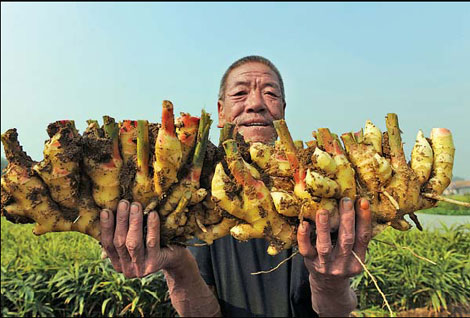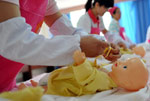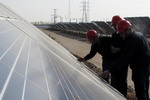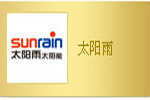The price is right as ginger growers enter cooperatives
Updated: 2011-11-07 11:13
By Zhao Ruixue and Wang Qian (China Daily)
|
|||||||||||
|
A farmer displays ginger in the village of Guanzhuang in Weifang City, Shandong province. Growers have sought to enter cooperatives with ginger-processing companies to hedge against price fluctuations. [Photo/China Daily] |
LAIWU, Shandong - Although he's disappointed with the decline in his earnings compared with last year, Zhu Hengjun, a 52-year-old ginger grower, feels fortunate that he has signed a contract with a processing company that offers a competitive price. Had he not done this, Zhu may have been facing serious losses, in common with many other growers this year.
"I heard that a lot of growers have suffered losses this year. To be honest, I feel lucky because at least I didn't lose money," said Zhu, from Zhangli Village in the city of Laiwu in East China's Shandong province.
Currently, 70 percent of the area planted with ginger in Laiwu is jointly developed by farmers and enterprise, according to Diao Yuzhao, deputy head of the Laicheng district of Laiwu.
Laiwu has 12,000 hectares available for cultivation of the crop, which accounts for 20 percent of China's total.
Zhu sold 6,000 kilograms (kg) of ginger produced on his 1,330 square meters of farmland to a local company at a price of 1.4 yuan (22 cents) a kg in mid-October. In doing so, he didn't earn much money but did manage to balance his costs of around 8,000 yuan.
In recent years, Chinese farmers have often suffered from the severe price turbulence that has affected crops such as ginger, garlic and mung beans. The uncertainties have forced them to seek new ways to hedge against losses caused by price fluctuations.
The price of ginger has risen rapidly in recent years, prompting an increasing number of farmers to grow the crop, However, in late October it slumped by more than 70 percent, compared with the same period in 2010.
In Laiwu, a major production base for ginger, farmers have sought to form a targeted sales relationship with the processing companies as insurance against the risk of fluctuating prices.
In such a set-up, businesses sign contracts with farmers to acquire their rights for land use (in China, all the land belongs to the State and farmers are leased the right to use it). Meanwhile, the companies employ the same farmers to plant ginger on their behalf. Therefore the farmers can earn a fixed salary in addition to a payment for the transfer of land-use rights.
Shen Guihai, from Gongjiazhuang Village in Laiwu, is a beneficiary of such a cooperative model. He grows ginger for Laiwu Manhing Vegetables Fruits Corp, which in 2007 acquired the rights to use almost all the farmland in Shen's village.
He can earn around 10,000 yuan annually, plus 1,200 yuan in rent from the transfer of his land-use rights to the company.
"Before, I could make only about 400 yuan a year, growing crops such as corn and peanuts," said Shen.
Farmers that don't participate in this type of cooperative - such as those in Anqiu City in Weifang, also a major center of ginger cultivation - are not as lucky as the residents of Laiwu.
According to Yang Chunqiang, deputy director of the Anqiu Agriculture Bureau, the average price paid for Anqiu's ginger was 0.8 yuan a kg on October 25, compared with about 10 yuan in November 2010.
"Oversupply is the main cause of the drop in price," said professor Xu Kun of the Department of Horticulture at Shandong Agricultural University, an expert in ginger planting and cultivation.
The root cause was the extremely high price of ginger last year, which resulted in an increase in the area planted with the crop, said Xu.
Farmers in Shandong have planted more ginger in the past two years as the sale price rose to 10 yuan a kg.
Xu estimated that ginger production in Shandong has increased by 50 percent this year, thanks to good weather and plentiful rainfall. In Laiwu, output has risen by 60 percent.
In the face of price uncertainty, Nie Binghua, director of the Shandong Economic Management Institute, suggested that all the growers in Shandong should adopt the large-scale model, similar to that in Laiwu.
"The individual farmers could not obtain sufficient market information (to hedge against risks)," said Nie.
Currently, Laiwu is home to 380 ginger-processing companies.
One of them is Manhing Vegetables Fruits Corp, China's largest exporter of ginger. It has acquired land-use rights for about 400 hectares and has signed contracts with more than 1,000 farmers to produce a total ginger-planting area of around 2,000 hectares.
Large-scale farming has not only enabled the company to increase output through the use of new technologies, but also to improve the farmers' earnings.
During the first three quarters of the year, Manhing exported ginger and related products worth $130 million.
The company's products are now seen on the shelves of the British supermarket giant Tesco PLC and in other stores in a number of European countries.
That may explain why the company can offer a reasonable price to farmers, despite the decline in the market price.
"Our price is about 10 percent higher than the market price for farmers who have a cooperative relationship with us," said Zhang Huayu, a manager at Manhing.
Related Stories
Drought fuels food price increases 2011-05-31 09:41
Measures 'ease food price surge' 2010-12-03 09:42
- Govt urged to open up crude oil import market
- Housing market close to turning point
- New turn in Saab quest for survival
- Macro-policy fine-tuning underway
- Cotton producer faces inventory pressures
- Appetite for home delivery meals rises
- Domestic toy market perks up
- Healthy outlook for medical tourists











